Hockey is a sport in which two teams play against each other by trying to manoeuvre a ball or a puck into the opponent's goal using a hockey stick. There are many types of hockey such as bandy, field hockey, ice hockey and rink hockey.

Ice hockey is a contact winter team sport played on ice skates, usually on an rink. Two opposing teams, typically fielding six skaters each, use sticks to shoot a vulcanized rubber puck into the other team's goal; the winner is the team to score most goals. In Canada, the United States, and some European countries the sport is known simply as hockey in everyday language; in virtually all other countries, "hockey" usually refers to field hockey.
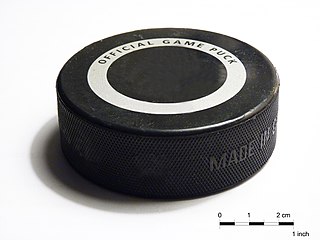
A hockey puck is a disk made of vulcanized rubber that serves the same functions in various games as a ball does in ball games. The best-known use of pucks is in ice hockey, a major international sport. A hockey puck has also been referred to as a "Flat Ball."

The Summit Series, or Super Series, known at the time simply as the Canada–USSR Series, was an eight-game ice hockey series between the Soviet Union and Canada, held in September 1972. It was the first competition between the Soviet national team and a Canadian team represented by professional players of the National Hockey League (NHL), known as Team Canada. It was the first international ice hockey competition for Canada after they had withdrawn from such competitions in a dispute with the International Ice Hockey Federation (IIHF). The series was organized with the intention to create a true best-against-best competition in the sport of ice hockey. The Soviets had become the dominant team in international competitions, in which the Canadian professionals were ineligible to play. Canada had had a long history of dominance of the sport prior to the Soviets' rise.

The center in ice hockey is a forward position of a player whose primary zone of play is the middle of the ice, away from the sideboards. Centers have more flexibility in their positioning and are expected to cover more ice surface than any other player. Centers are ideally stronger, faster skaters who can back-check quickly from deep in the opposing zone. Generally, centers are expected to be gifted passers more than goal scorers, although there are exceptions, typically larger centers who position themselves directly in front of the net in order to score off rebounds. They are also expected to have exceptional "ice vision", intelligence, and creativity. They also generally are the most defensively-oriented forwards on the ice. Centers usually play as part of a line of players that are substituted frequently to keep fresh and keep the game moving.
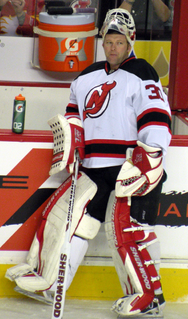
In ice hockey, the goaltender is the player responsible for preventing the hockey puck from entering their team's net, thus preventing the opposing team from scoring. The goaltender usually plays in or near the area in front of the net called the goal crease. Goaltenders tend to stay at or beyond the top of the crease to cut down on the angle of shots. In today's age of goaltending there are two common styles, butterfly and hybrid. Because of the power of shots, the goaltender wears special equipment designed to protect the body from direct impact. The goalie is one of the most valuable players on the ice, as their performance can greatly change the outcome or score of the game. One-on-one situations, such as breakaways and shootouts, have the tendency to highlight a goaltender's pure skill, or lack thereof. No more than one goaltender is allowed to be on the ice for each team at any given time. Teams are not required to use a goaltender and may instead opt to play with an additional skater, but the defensive disadvantage this poses generally means that the strategy is only used as a desperation maneuver when trailing late in a game or can be used if the opposing team has a delayed penalty.

A penalty in ice hockey is a punishment for an infringement of the rules. Most penalties are enforced by sending the offending player to a penalty box for a set number of minutes. During the penalty the player may not participate in play. Penalties are called and enforced by the referee, or in some cases, the linesman. The offending team may not replace the player on the ice, leaving them short-handed as opposed to full strength. When the opposing team is said to be on a power play, they will have one more player on the ice than the short-handed team. The short-handed team is said to be "on the penalty kill" until the penalty expires and the penalized player returns to play. While standards vary somewhat between leagues, most leagues recognize several common varieties of penalties, as well as common infractions.
Checking in ice hockey is any of a number of defensive techniques aimed at disrupting an opponent with possession of the puck or separating them from the puck entirely. Most types are not subject to penalty.
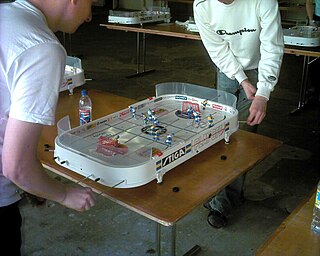
The International Table Hockey Federation (ITHF) is an organization that oversees table hockey competitions. The origin of the sport was the Swedish Championship 1982 in Upplands Väsby. Organized table hockey is played in northern, central and eastern Europe, in North America, but table hockey is also played in South America, Africa, Australia, and Asia.
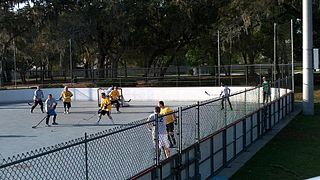
Street hockey is a variation of the sport of ice hockey where the game is played outdoors on foot, or with inline or roller skates using a ball or puck. Both ball and puck are typically designed to be played on non-ice surfaces. The object of the game is to score more goals than the opposing team by shooting the ball or puck into the opposing team's net. Street hockey in pickup form is generally played under the following guidelines since there are no "official rules" for local pickup hockey:
Floor hockey is a family of indoor hockey games.

Roller inline hockey, or inline hockey is a variant of hockey played on a hard, smooth surface, with players using inline skates to move and hockey sticks to shoot a hard, plastic puck into their opponent's goal to score points. There are five players including the goalkeeper from each team on the rink at a time, while teams normally consist of 16 players.
Super Chexx® is a table hockey arcade game manufactured by Innovative Concepts in Entertainment, Inc. (ICE) from 1988 to 2017. ICE began manufacturing CHEXX bubble hockey in 1982 and it quickly became one of the top-earning bar and arcade games of the 1980s. Enhancements to the game were added and it was renamed Super Chexx in 1988 and it continued to be popular in bars and arcades and received national acclaim during the Bud Light Bubble Boys tournament series from 1999-2001. In November 2017 Super Chexx was replaced with the Super Chexx Pro edition using enhanced electronics featuring a 5" LCD jumbotron and LED lighting. Super Chexx Pro is still made in the USA in Clarence, New York just outside Buffalo. These types of games are also known as bubble hockey, rod hockey, table hockey or dome hockey because of the long rods used to control the players and the distinctive dome or "bubble" covering the playing field.
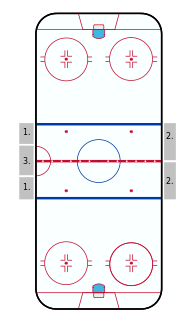
The National Hockey League rules are the rules governing the play of the National Hockey League (NHL), a professional ice hockey organization. Infractions of the rules, such as offside and icing, lead to a stoppage of play and subsequent to the offending teams. The league also determines the specifications for playing equipment used in its games.
This is a list of common terms used in ice hockey along with the definition of these terms.
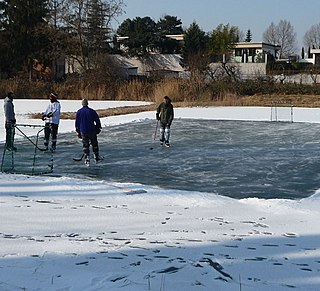
Pond hockey is a form of ice hockey similar in its object and appearance to traditional ice hockey, but simplified and designed to be played on part of a natural frozen body of water. The rink is 50 to 80 percent the size of a standard NHL-specification rink, and has no boards or glass surrounding it; usually only a barrier of snow keeps the puck in play. In addition, because there are no protective barriers behind the goal to contain high errant shots, the top of the goal is lower, in fact only slightly taller than the width of a puck, and the game does not have a formal goalie. Because of these differences, pond hockey places more emphasis on skating and puckhandling ability and less on shooting and checking. Non-competitive pond hockey is played with improvised goals, rinks of a variety of sizes, and no boards or snow barriers. There can only be 4 players playing per team at a time but have many subs to sub in.
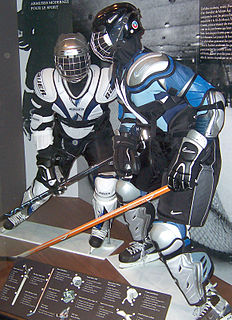
In ice hockey, players use specialized equipment both to facilitate the play of the game and for protection as this is a sport where injuries are common, therefore, all players are encouraged to protect their bodies from bruises and severe fractures.
Box hockey is an active hand game played between two people with sticks, a puck and a compartmented box, and typically played outdoors. The object of the game is to move a hockey puck through the center dividers, of the box, out through a hole placed at each end of the box, also known as the goal. The two players face one another on either side of the box, and each attempts to move the puck to their left. If a player succeeds in getting the puck to exit the box through the goal, the player scores one point. The first player to score the predetermined number of goals wins the game.
The Hockey Canada Officiating Program(sometimes abbreviated HCOP or less commonly CHOP) is the governing body for on-ice officials for all ice hockey games played under the jurisdiction of Hockey Canada. The Hockey Canada Rulebook provides in-depth explanation and examples of all rules governing hockey in Canada.
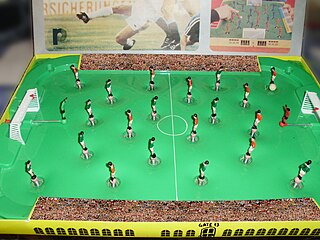
Tabletop football is a class of tabletop game simulating association football (soccer), either of the codes of rugby, or some other form of football such as American football or Australian-rules football. The games employ miniature figures of players on a bounded playing board or table that looks like a football pitch (field).















